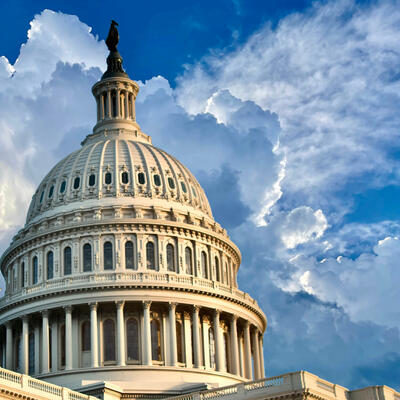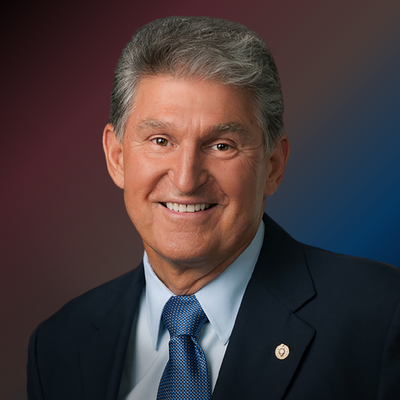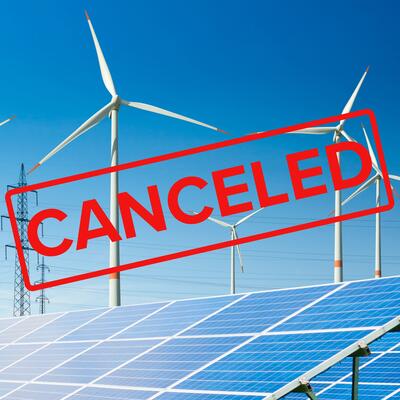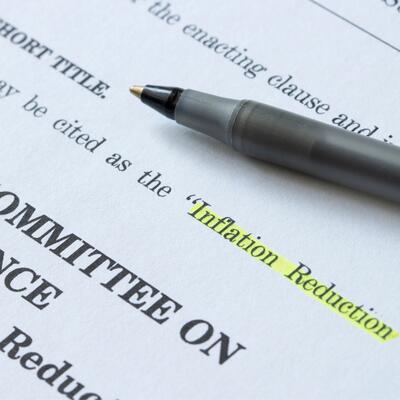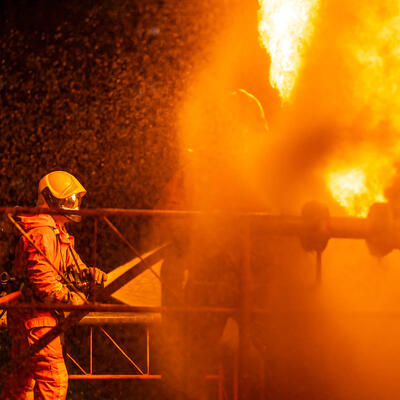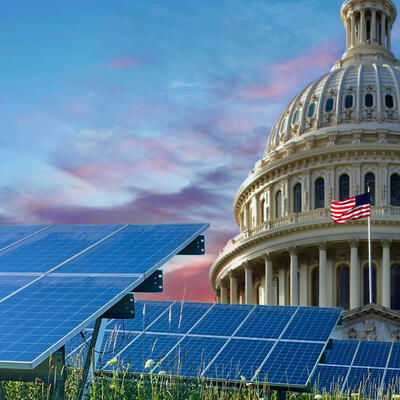
The Inflation Reduction Act Passed. Now What?
Guests
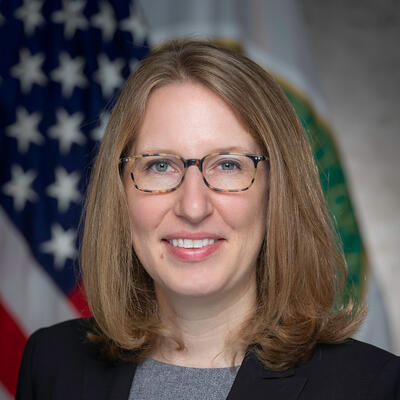
Carla Frisch

Ryan Panchadsaram

Erwin Chemerinsky

Dan Bowerson
Summary
In August, President Biden signed the Inflation Reduction Act into law. The IRA allocates around $370 billion over ten years to invest in renewable energy, make EVs more affordable, address climate inequities, reduce greenhouse gas emissions and help mitigate the climate crisis.
The IRA follows the passage of the bipartisan CHIPS and Science Act and Bipartisan Infrastructure Act. Taken together, the Biden administration hopes to jump-start a new era of U.S.-led innovation, research and economic growth. Carla Frisch, Principal Deputy Director at the Office of Policy for the U.S. Department of Energy, paints the picture of how the three bills work together:
“The analogy there we’ve been thinking about is the backbone, the brain and the lungs. So, the backbone being the Bipartisan Infrastructure Law...Then there's the brain, the CHIPS and Science Act and chips being the semiconductors that are in our cars, our computers, our cellphones. And then the third piece is the lung. So, breathing into that clean energy economy, the Inflation Reduction Act incentivizes deployment of clean technologies and really focus on lowering costs for American families.”
But like any law, the way the money is doled out matters, and the law’s implementation will ultimately determine its success. Frisch explains, “It does take time but I can tell you we’ve got a very committed team in the federal government right now and civil servants who are digging in and been waiting for the opportunity to rent some of these programs and already really moving forward quickly.”
Ryan Panchadsaram is adviser to the chairman of venture capital firm Kleiner Perkins, co-author of Speed & Scale, and also served as Deputy Chief Technology Officer of the United States during the Obama Administration. He says, “One thing to think about is actually as a series of laws that have passed that are going to make a lot of the climate realities we want to come to bear. So, in the earlier laws you have demonstration projects you have funding from things like the loan program office now they can support the building out of factories and facilities. And then you have really demand oriented incentives to make the purchasing of it cheaper in the market, right. So, you actually can get not only the factories created the supply there and actually the demand flowing.”
The Inflation Reduction Act promises to pour a ton of money into electrifying transportation. But new rules now restrict which electric vehicles qualify for a $7500 tax credit, limiting the cash back to models made in North America. But that’s only until January, then there are even more rules. Dan Bowerson, Senior Director of Energy & Environment at the Alliance for Automotive Innovation, the car industry trade group, explains:
“It gets much more complicated starting in January 1, 2023. So, the first thing that happens is that 200,000 vehicle cap is gone. So, for companies that had already hits that cap General Motors and Tesla that cap is no longer in play. It also implements a MSRP cap. So, it's $80,000 for vans, SUVs and pickups and $55,000 for cars. We also see the implementation of income cap. So, for couples filing jointly if you make over $300,000 you would not be eligible for a tax credit. And for individuals making over 150,000 you would be ineligible.”
In addition to all of the money and programs written into the IRA, legislators also defined carbon dioxide and other greenhouse gasses as pollutants. This is seen as an attempt to mitigate the damage done by the Supreme Court’s West Virginia v. EPA ruling, which severely limited the EPA’s ability to regulate greenhouse gas emissions. Dean of Berkeley Law Erwin Chemerinsky explains how the Congressional clarification might affect the implementation of the Supreme Court’s ruling:
“I think it changes the impact in that it makes clear that greenhouse gas emissions. Are pollutants. On the other hand, I don't know that that addresses the concern that the Supreme court had in West Virginia versus EPA, West Virginia versus EPA said the Congress hadn't been sufficiently specific in giving EPA the authority to regulate power plants in a certain way. So as to reduce greenhouse gas emissions or to put it most simply, I think it goes part of the way to addressing what the Supreme court said, but it doesn't go all the way.”
Related Links:
4 Underrated Parts of IRA
The Pivotal Role for States in Implementing the IRA
Red States Reap Inflation Bill’s Green Benefits
The Inflation Reduction Act doesn’t get around the Supreme Court’s climate ruling in West Virginia v. EPA
Speed & Scale
Full Transcript
Note: Transcripts are generated using a combination of automated software and human transcribers, and may contain errors. Please check the actual audio before quoting it.
Greg Dalton: This is Climate One. I’m Greg Dalton. In August President Biden signed the Inflation Reduction Act into law. The IRA allocates around $370 billion over ten years to invest in renewable energy, make EVs more affordable, address climate inequities, reduce greenhouse gas emissions and help mitigate the climate crisis.
The IRA follows the passage of the bipartisan CHIPS and Science Act and Bipartisan Infrastructure Act. Taken together, the Biden administration hopes to jump-start a new era of U.S.-led innovation, research and economic growth.
But like any law, the way the money is doled out matters, and the law’s implementation will ultimately determine its success. Some of the IRA money moves through state governments, including some that are outright hostile to the law. Consumers will have access to a suite of rebates and credits designed to electrify their lives, if they can get the necessary support to take advantage of them. So how do we take the law from words on a page to real functioning programs?
Carla Frisch is Principal Deputy Director of the Office of Policy at the U.S. Department of Energy. She previously spoke with Climate One about the bipartisan Infrastructure law. We invited her back to discuss the passage of a second big win.
Carla Frisch: It is remarkable. And I’d even say three, actually, if you add the CHIPS and Science Act in. So, the analogy there we’ve been thinking about is the backbone the brain and the lungs. So, the backbone being the Bipartisan Infrastructure Law that was put into law last November 2021 that we’ve talked about and DOE has made significant strides on implementation. That law was the largest long-term investment in US infrastructure in nearly a century. Roads and bridges including significant energy infrastructure. Then there's the brain, the CHIPS and Science Act and chips being the semiconductors that are in our cars, our computers, our cellphones. The production of those has been taken over by several other countries and that is a foundational investment in US competitiveness in chips. And the science part authorizes additional investments from Congress in science that National Science Foundation and DOE. And then the third piece is the lung. So, breathing into that clean energy economy the Inflation Reduction Act incentivizes deployment of clean technologies and really focus on lowering costs for American families. And of course, that was most recently put into law and we’re working through what are all the implications of those investments now.
Greg Dalton: Right. So, there's manufacturing technology, you know, some things playing on different parts of the economy, different timescales. And the DOE estimates that the IRA and the infrastructure act along with other enacted policies would put the US on a path to reduce nationwide greenhouse gas pollution about 40% in the next year as compared to the baseline, which happens to be 2005 levels.
Carla Frisch: It is really good news from an emissions perspective. And the 40% is from those two bills and then there's additional emissions reductions that will continue to come from state and local governments who’ve been very active in the emissions and clean energy space. Private sector we see all kinds of announcements coming, and of course continued federal government action beyond what's already happened in those two pieces of legislation. So, an important thing to remember too is for a long time people thought about our energy use, our emissions and our economic growth as connected indicators. And they are connected but we can continue to have really strong economic growth while we have really strong emissions reductions. Same thing with our energy use and our emissions reductions. Those are decoupled now; those are separate metrics. Because we’ve got to continue the economic growth and then emissions going down quite strongly.
Greg Dalton: Right. That decoupling has been the goal. You have one go up and one curve growth go up and emissions go down. The Infrastructure Act makes big investments in the nation's electric grid. How will that dovetail with new energy production boosted by this Inflation Reduction Act?
Carla Frisch: It’s really exciting. So, across the Bipartisan Infrastructure Law and the Inflation Reduction Act we’re looking at the full spectrum of research and development to large-scale demonstrations through the Bipartisan Infrastructure Law and then significant further deployment through Inflation Reduction Act. There’s a connection for example, in the Bipartisan Infrastructure Law will be doing significant demonstrations in hydrogen and carbon capture and storage. And then in the Inflation Reduction Act you see the next set of policies largely tax policy that provides some certainty to investors to be able to take those projects from a large-scale demonstration to further deployment. So, across the Inflation Reduction Act, I really think of it in two buckets plus an underpinning. Those buckets being significant investment through taxes and the new programs and loans. So, on the tax front, there’s tax incentives for individuals and families and we’ve had before but those are getting larger in many cases. And then there's tax incentives for the private sector for companies that are building, installing clean energy technologies. And those tax incentives for the private sector in the past in the US the last 10 to 15 years we’ve had a bit of an on-again off-again policy that's provided some real uncertainty for investors. And this IRA was done through a process called budget reconciliation which means it requires spending money and it's over a 10-year horizon. So, the law provides 10 years of certainty for those investors about what the tax policy will be. And some significant expansions for example, we talk a lot about the investment tax credit and the production tax credit for solar and wind. Those also apply now to storage, to new nuclear there's incentives for hydrogen some really significant changes in those tax investments. Then the second bucket being new programs including loans. So, at Department of Energy that includes 5.8 billion in advanced industrial deployments. For example, getting to the next generation of steel and cement with much lower emissions. It includes new rebate programs that will dovetail with the tax incentives for individuals and families and it includes a really significant investment in our loan programs office. And those kinds of investments on a loan, we can provide a loan, we can provide a loan guarantee with a smaller amount of money that can really be leveraged by private-sector uptake. So, that office has been ramping their work back up really significantly recently and has much more room to do so now with the Inflation Reduction Act. And then all of that has the significant underpinning of a focus on jobs on domestic manufacturing and on justice.
Greg Dalton: Can you give us an example? I know it’s early days, and this is probably the rules aren’t totally set yet. The Department of Treasury is working on some of the implementation rules. But are there examples of the types of projects that might get funding with all this new expansion of federal loan programs?
Carla Frisch: Yes, all kinds of projects. So, you could think about build out of wind and solar facilities. You could think about build out of advanced manufacturing in the United States advanced industrial processes. This is a foundational change to the US energy economy. And we’ll be talking about it. I bet you’ll be doing podcasts about it for years to come. Really significant change to the investments in the US.
Greg Dalton: Though this has happened before you know the Stimulus Act after the great recession financial crisis of 2008, 2009. What most people remember about that chapter is a company named Solyndra, which failed and then although I think the loan portfolio overall did very well and Tesla got funding and paid it back early and is hugely successful. The narrative was lost last time for a number of reasons. So, what is being done this time to have the more realistic, authentic narrative of these programs.
Carla Frisch: Well, we’re counting on you to help us get the story out, Greg. So, our loan programs office even just recently before Inflation Reduction Act has announced several new loans. 500 million loan guarantee for an advanced clean energy storage project in Utah which is a really innovative use of hydrogen based long-term energy storage in July alone to see our technologies to expand manufacturing facilities to produce materials used in electric vehicle batteries. And then also recently a conditional commitment for Ultium Cells to manufacture lithium-ion cells for electric vehicles. So, that office has been very active and part of the government role is to take on a little bit extra risk. Otherwise the private sector would be doing it on its own. So, we have a special role there with the loan programs office. But the new elements of the Inflation Reduction Act it includes almost an additional 40 billion in loan authority for innovative technologies. It eliminates a cap on advanced vehicle manufacturing loans so we can do more in that area. And it includes a brand-new program which I'm really excited about that focuses on reinvesting in clean energy in communities that already have existing or retired fossil fuel infrastructure. So, it really focuses on communities and how can we help them get to the future that they want.
Greg Dalton: All these things some promising at this point the reason we’re having this conversation is about implementation. There have been reports of long donate delays in permitting approvals for renewable energy. So, what’s gonna be done to sort of make sure that this stuff happens quickly and on time because there is a concern that like some people you want to see results pretty quickly, right, and this stuff takes a long time.
Carla Frisch: It does take time but I can tell you we’ve got a very committed team in the federal government right now and civil servants who are digging in and been waiting for the opportunity to rent some of these programs and already really moving forward quickly. On permitting for example, there is a parallel piece of legislation being discussed now that would focus on streamlining permitting for energy and transmission projects both for clean energy and fossil fuels --
Greg Dalton: That’s highly controversial. Lot of people are really worried about what could happen there with pipelines in West Virginia, etc. the Manchin side deal.
Carla Frisch: Right. But the IRA itself includes several provisions to make the permitting process more timely. So, that includes through DOE grants to facilitate and accelerate siting and permitting for high-voltage interstate and for offshore transmission projects. Funding to support hiring and training personnel, equipment, community engagements really helping accelerate some of the processes that we have in place in the federal government on the permitting front. Because that’s an area where we think we can do more.
Greg Dalton: Block grants, you know, there might be some blockages. That's been a problem so far. Some of those like home efficiency and improvement ones will be dispersed through the states. And there are Republican governors and states with big wind resources for example, who opposed the law. So, how can the DOE navigate working through governors who frankly don't want this bill to be a success? moving money through states that are not cooperative?
Carla Frisch: We have seen governors across the US really focused on investments in clean energy and investments for their residents, whatever party they're part of. So, there's an extended set of tax credits for consumers so, we talked about the EV tax credits. For homes and businesses there is a set of tax credits for energy efficiency which starting in January will go up in the amount and those are available to everyone. And then additionally as you mentioned, there's a new rebate program flowing through DOE to the states something we did before back in the Recovery Act in 2009. And that rebate program includes special incentives eligible for low income residents. So, incentives especially designed for low income, which could include a rebate of up to $8000 for a new heat pump which provides heating and cooling, and that's two to three times more efficient than other equipment. And separate rebates for whole home retrofit if you're doing a whole building at the same time. And those rebates are up to $4000 for all families and up to $8000 for low income homes. So, those are new so we’ve got a little bit of work to do to set them up and put them in place. But it's really expanding opportunities, particularly for low income individuals and families.
Greg Dalton: There’s also $20 billion for agricultural conservation practices and about 5 billion for forest conservation and tree planting. Let's not forget that piece of this. So, why are these natural solutions where do they fit into the puzzle?
Carla Frisch: Well, natural solutions are a big part of climate. If you think about the fact that those trees and the things who are growing in agriculture are sequestering the carbon and they're the most efficient at doing that about getting the carbon dioxide out of the atmosphere. And when you look at IRA overall as a person who spent some of my career writing and reviewing reports about what to do about climate change one pattern you see in those reports and you’ve talked about this, is there's no one solution. We’ve got to work on agriculture, forestry, lands, land use we’ve got to work in energy on electricity sector on transportation on residential and commercial buildings on industry. And each of those sectors has really significant opportunities. And when you look across IRA it matches one of many of those reports about the pieces and parts across the different sectors. So, there's a lot in it because there's a lot of solutions that are necessary. And it’s really amazing to me and the breadth and depth of concrete solutions that are embedded in this law.
Greg Dalton: Right. And there’s a lot of industry on board which certainly gives me hope this time. Because by and large we talk to the auto industry elsewhere in this episode, and talking to industry people they’re pretty much on board on this because there are a lot of carrots, a lot of incentives for this. Whereas 10 years ago, industry was in a very, certainly auto industry was in a very different place, trying to slow things down so that's encouraging. Though Democrats as you noted, did do this through the reconciliation process which has a 10-year time horizon. And there were no Republican votes and, you know, other things when one party does something through reconciliation the other party sometimes try to take a sledgehammer to it when they can. How much can be undone by the next Republican administration?
Carla Frisch: Right. So, you mentioned IRA was passed through the Senate and the House by all Democrats. And the Bipartisan Infrastructure Law and the CHIPS and Science Acts were passed with bipartisan support from both parties. So, those are all laws now. So, to undo a law of course you’ve got to go back to the Senate, the House and the President. This law in particular is really focused on spending. So, a lot of those programs are getting set up and put in progress now. So, I do think that those will have a lasting effect. And you mentioned industry as well. We have seen even since this was signed into law several new announcements from industry, saying because of the Inflation Reduction Act we are investing more in the US. That includes an announcement from First Solar, they’re the largest domestic manufacturer of solar. We’ve got a lot of the supply chain for solar right now is in China. And so, we are playing catch-up on that supply chain. And they announced that because of IRA they are investing 1.2 billion to expand their operations with a new manufacturing facility in the US southeast and expanding their existing footprint in Northwest Ohio. We also saw new announcements from a company called Sparkz with a Z, that will locate an electric battery factory in northwestern West Virginia. Honda Motor and LG Energy Solution announced plans to build a new battery production plant for EVs in the US. And Toyota announced a global expansion and spending on EV battery manufacturing including 2.5 billion earmarked for a new battery manufacturing facility in Liberty, North Carolina. So, that's just in a few weeks since this came into law. This law for the first time in the country's history as I understand, we are using tax incentives, specifically energy tax incentives to uphold and improve job quality. So, one of the foundational principles of the tax credits and other parts of IRA are a focus on prevailing wage and apprenticeship requirements. So, embedded in the structure and the design of the tax credits is this explicit focus on labor. And those two are tied together in a way that we have not seen before and it creates a really significant opportunity both for expansion of clean energy but also for expanded job opportunities and for the expanded quality of those job opportunities. And as we continue to make more investments here in the US of having the domestic supply chain, of having strong quality job opportunities and building out more justice, we are creating a real opportunity that people will want to continue to grow.
Greg Dalton: Carla Frisch is Principal Deputy Director of the Office of Policy at the US Department of Energy. Carla, thanks for sharing your insights on the sprawling and promising climate law at last.
Carla Frisch: Thanks so much for having me.
Greg Dalton: We’ll be right back
Greg Dalton: This is Climate One. I’m Greg Dalton. The Inflation Reduction Act has multiple incentives that were designed to help bring down the cost of clean tech and speed up mass adoption.
Ryan Panchadsaram is senior adviser to the chairman venture capital firm at Kleiner Perkins, and co-author of Speed & Scale. He served as Deputy Chief Technology Officer of the United States during the Obama Administration. He talked with Climate One’s Ariana Brocious about the new law.
Ariana Brocious: The Inflation Reduction Act includes the largest amount of climate funding we've seen, about 370 billion. And the consumer facing side of things like tax incentives for EVs and home improvements have gotten a lot of attention. But what part of this law is most exciting to you?
Ryan Panchadsaram: Yeah, Ariana, the most exciting part of this law is that before it, the United States did not have significant climate policy that was market-driven, right. And so, when you think about the clean energy deployment that we need the electrification of vehicles that we depend on. There are parts of this bill that make that happen, right. And so, that's what's incredibly exciting is it actually puts America in the fight, whereas if we were having this conversation just a few weeks ago, a month ago, we be trying to figure out how states could pick up the gap or how companies could do things or we’d be talking about other countries and how they inspire us. And today we have the Inflation Reduction Act, which is a significant climate bill that we can celebrate as an American thing.
Ariana Brocious: So, this law expands clean energy tax credits for wind, solar, clean hydrogen and other clean fuels. What difference do you see this making for things like hydrogen and other clean fuels?
Ryan Panchadsaram: Yeah, so, for clean fuels, you know, that's where industry is still incredibly nascent. When you think about the hydrogen fuels that we need and can exist In both this bill and if you rewind back to the bipartisan infrastructure law there’s funding in that to create demonstration plants, right. And so, I think one thing to think about is actually as a series of laws that have passed that are going to make a lot of the climate realities we want to come to bear. So, in the earlier laws you have demonstration projects, you have funding from things like the loan program office now they can support the building out of factories and facilities. And then you have really demand oriented incentives to make the purchasing of it cheaper in the market, right. So, you actually can get not only the factories created the supply there and actually the demand flowing. And so, this is sort of a very thoughtful approach on making some of these technologies that don't exist at scale today to come to fruition.
Ariana Brocious: Right. And I'm curious, What is gonna make them marketable and how will this help?
Ryan Panchadsaram: For a lot of clean technologies they are expensive, more expensive than the fossil fuel burning equivalent. In some areas like solar and wind we’ve this aggressive price drop over the past two decades. And now that green premium doesn't exist anymore for them. There truly are a green discount when you think about them, right, picking those are cheaper. But when you think about some categories of electric vehicles when you think about sustainable air fuel those are still more expensive than if you or I will just to go buy a normal car or try to just hop on a flight, flying normal air fuel. And so, a lot of the policies in this law are trying to help drive down that cost curve. And the way you do that is by actually producing more, purchasing more. And so, this is a strong form of American industrial policy saying we believe these are gonna be industries in the future. How do we support them? How do we make them cheaper so consumers can then be able to afford them out right when these policies end up fading out?
Ariana Brocious: And what about the timeline for these types of technology and maybe we can also expand this to talk about battery technology. The timeline for making this, you know, bringing those costs down, making them much more accessible.
Ryan Panchadsaram: So, the new thing is for battery technologies in Speed & Scale we have this tracker that looks at a few handfuls of key results. Key things and key measures that need to be on track if we want to remove the carbon pollution that we produce. And for batteries the price of that has dropped so significantly in the past 10 years, and not just that the scale of building them have picked up. And so, from a cost point of view those that you know trajectory is there; it's one that now the question is where we gonna purchase those batteries from. If you look at the Inflation Reduction Act there is in the EV policies it actually changes it to now, you know, it only applies to vehicles built in North America. And then when you look at it there is a ratcheting up of well, where do the batteries and minerals come from too. They’ve got to come from US and their allies. And so, here you're seeing, one, yes, it's possible to produce batteries at scale cheaply. But we want them to be produced here or between one of our trading partners.
Ariana Brocious: Among some of the other technologies that are getting boosts from this bill is carbon capture and storage. This is somewhat controversial among climate experts and environmentalists. Many say it’s ineffective and will actually keep us more reliant on fossil fuels into the future or for longer and that the money could be better spent on proven technologies like wind and solar. Carbon capture and storage usually refer to capturing carbon dioxide at the source of the pollution like a coal plant that's distinct from direct air capture which sucks carbon pollution carbon dioxide that may have been emitted many years ago out of the air. So, right now the second direct air capture is very expensive and I'm curious what you think about government money going to those kinds of projects when there are as we've said some of these other things we can and should be investing in.
Ryan Panchadsaram: Yeah. So, the first category, so I think money should be going into absolutely the direct air capture type project. Because we need to explore them, we need to build them up. But then there’s this category of projects that do get funding that you can take CO2 from industrial processes and use it for enhanced oil recovery. I don't think that's the right way or really the way we’re gonna get ourselves out of this. That's just a way of pumping more oil and getting a credit for it. And so, I personally of course, disagree with that
Ariana Brocious: How will the funding drive more research and development in consumer tech like better and more affordable heat pumps and electric water heaters maybe for example?
Ryan Panchadsaram: You know, there's a set of funding in the IRA called the high-efficiency electric home rebate program, right. It's gonna provide a good chunk of money to help with assisting around anything certified by the Energy Star program, right, around heat pumps and electric stoves and better insulation. And it's targeted to low-income families and to really support the transition. Because sometimes those choices are more expensive up front, but the savings that actually come from lower energy costs truly make that you know return on investment calculation quite a good one for most families. And, you know, one thing to think about right now too on this whole electrification shift as well as using less energy, more energy efficiency you're seeing this crisis happen around the globe right now around natural gas prices as well as oil prices. And we have to look at well, one, how do we cut our emissions, but in every bit of energy that we do use, how do we conserve as much of it as we can. And there are new technologies like heat pumps, so of instead of burning natural gas in your home you're actually using this thermal exchanger that’s able to be both heat and air-conditioning for you. And it’s able to do it using only electricity, able to do it incredibly efficiently which means you spend less on energy. And I think you're gonna see not only the IRA really pushing these advances, but just general global factors and reasons encouraging more energy efficiency to happen.
Ariana Brocious: You worked as deputy chief technology officer in the Obama administration. So, can you tell us about how federal money like this rolls out and how quickly we might see the money hit the road, so to speak and begin to take effect?
Ryan Panchadsaram: Yeah. It’s all about the implementation now, right. So, the President, Congress have done their part which is to appropriate the money needed to instigate the shift. But within the Department of Energy within the loan program office within each of these offices that have now been appropriated dollars this is where the work starts. They’re gonna be doing outreach actively and immediately understanding from the business community, as well as from the climate community how to deploy these dollars well. And so, I'll say, Ariana, the process is absolutely happening immediately. The question, of course, when the money comes out each of the programs is able to do it at different timelines. But what's neat is there's already that process flowing from the bipartisan infrastructure law, right. So, there's a lot of demonstration projects that they're already evaluating and looking at. And so, I think we’re gonna see a lot of successes and announcements as this year closes out and into the next, and even more, the year after. but it really is about the execution of the law now too. I think it is worth saying, for any law, right. It could be implemented poorly. So, this investment that we’re making as a country could be spent poorly and it could be also spent incredibly well.
Ariana Brocious: And do you see any obvious pitfalls in the way the IRA and the funding works that might limit its impact in terms of that implantation?
Ryan Panchadsaram: The way that IRA came together was, you had a whole good year and a half of work on a build back better, on different great ideas and how to move the US to a carbon free country. And when the bill got shuttered, I don’t think anyone had hoped that it would resurrect itself. And when it did to see so many components of the market-based things in there, right, the tax credits, to see components in there around supporting the carbon removal pieces. You got really at least excited that this was a bill that was supporting the market in driving this, right, which is an important piece. But the other things in the bill were the trade-offs that we’re around oil and gas leasing. And the unfortunate thing is, in this moment in time this bill, while it does, I think the way the analysis looks, it goes for every ton of emissions that are generated by these oil and gas provisions, 24 tons are removed. So, for every ton, 24 are removed. And so, from, you know, zooming out and looking at the big picture of the world and emissions this bill is phenomenal. But when you go back to the local level, right, to the families and communities that live next to an oil well that's not being shuttered when you go to a community that still has a coal plant. This extends its life. And so, this trade-off was made and but what it means is that there’s still plenty of work to be done that can happen at the EPA. There's so much work that can be done to happen at the state level, right. Federal government is doing its part. What are the states gonna do? What are local governments gonna do? And so, that's where to focus the energies.
Ariana Brocious: So, what are some of the other ripple effects that we might see once this bill takes hold. I think about it in terms of there being some kind of tipping point, right, where even if the investments in some of these technologies could seem modest there is enough of it happening all at once that the sector just kind of moves ahead.
Ryan Panchadsaram: So, on the policy side, yet legitimate policy and then as a consumer, right. So, like there are policy tsunamis, right, I think one of them that's happening right now that’s like starting to form is around banning gas in buildings and helping people transition to heat pumps as well as induction stoves. You have multiple cities across the country that have passed these bills and more are following suit. And it's an incredible way to not only remove the emissions footprint of a city, but to have clean air in your home. Remember, when you have a stove and you turn it on just even boiling water on it, that's burning natural gas and methane inside your house. And so, one, if you have that please turn on the vents but two, look at that and see that you are combusting something in there and it’s actually affecting the air quality. And so, that's one I think tide that you're seeing coming from like a policy point of view. On the market side, you know, when you look at project financing, right. This is the money that goes out there to help support these solar projects and wind projects and now storage projects as well too. A lot of projects, I mean project financing isn't charity work, it's a bank coming out there and saying based on the tax code and the incentives what is truly a profitable thing to deploy. And you’re just seeing so much solar, wind, and now because storage prices are dropping being deployed. And so, that's a tsunami wave when some public utility commission or a city or even a company that has a large facility getting built when they do the math around what's the right energy choice the neat thing is the clean energy choice is one that can be proven to be cheaper and more resilient. My co-author, John Doerr has this incredible saying which is when the right thing becomes the profitable thing it’ll be the probable thing. And so, when you actually have something that's profitable, which tends to mean that the green premium is gone and that green discount’s there, market forces get to take over, Ariana, and then this transition goes blazingly fast. Oh, I think the place where you’re actually seeing that is truly in electric vehicles, right, year-over-year. Just two years ago it was like 3% then it was 6% and then just at the end of last year globally was like 12% electric vehicles purchased. In China it was 26%. In countries like Norway, you had near 100%. And so, that's where you know this transition becomes really optimistic and I get very hopeful, you know, I think there's a lot of folks in the climate community they’ve been fighting this fight for 20,30+ years. And I think for a lot of us that are coming in, maybe let’s just say in the past five, one, we get to stand on their shoulders and get really build on their work, but we also get to take advantage of the market forces that exist today where the clean green thing is cheaper. And for the things that aren't we have policies in place to help drive them down. And so, we've got a lot of work to do to implement the parts that IRA is supporting. Cleaner grid, clean vehicles fixing our food system, protecting nature, cleaning up our industry and then removing carbon. If we can do all those things, we’re gonna be in a wonderful place at the end of this decade with the momentum that we need to get to zero by 2050.
Ariana Brocious: Ryan Panchadsaram is adviser to the chairman at Kleiner Perkins and co-author of Speed & Scale. Thanks, Ryan, for joining us on Climate One.
Ryan Panchadsaram: It’s wonderful to be here.
Greg Dalton: This is Climate One. I’m Greg Dalton. In addition to all of the money and programs written into the IRA, legislators also defined carbon dioxide and other greenhouse gasses as pollutants. This is seen as an attempt to mitigate the damage done by the Supreme Court’s West Virginia v. EPA ruling, which severely limited the EPA’s ability to regulate greenhouse gas emissions.
Climate One’s Ariana Brocious spoke with Erwin Chemerinsky, Dean of Berkeley Law, to find out how that Congressional clarification might affect the implementation of the Supreme Court’s ruling.
Erwin Chemerinsky: I think it changes the impact in that it makes clear that greenhouse gas emissions are pollutants. On the other hand, I don't know that that addresses the concern that the Supreme Court had in West Virginia versus EPA, West Virginia versus EPA said the Congress hadn't been sufficiently specific in giving EPA the authority to regulate power plants in a certain way, so as to reduce greenhouse gas emissions or to put it most simply, I think it goes part of the way to addressing what the Supreme court said, but it doesn't go all the way.
Ariana Brocious: And I've seen different interpretations by legal experts about the impact of this wording. So what's the sort of, um, far end that you've seen, in terms of the most, the most significant implication of what the wording could be in favor of the EPA’s authority.
Erwin Chemerinsky: It has to remember that the clean air act was adopted 50 years ago. And as a result, it wasn't adopted with a thought towards greenhouse gas emissions. This is unequivocally making clear that the EPA does have the authority generally to regulate greenhouse gas emissions.
Ariana Brocious: But it may not be specific to power plants and in the applications such as the clean power plan that the Obama administration tried to put forward.
Erwin Chemerinsky: The question is whether this change in the law is enough to give the Biden administration the ability to regulate greenhouse gas emissions from power plants. Chief justice Roberts opinion in West Virginia versus EPA said that the EPA was using an obscure provision in the Clean Air Act that no one had ever thought included regulating power plants in this way. And I think the question is, is changing the definition of pollution to include greenhouse gas emissions enough to address that concern.
Ariana Brocious: And how will we find the answer to that question? Just by seeing it play out?
Erwin Chemerinsky: The Biden administration has said that it's gonna adapt its own plan for regulating greenhouse gas emissions from power plants. It's important to put in context, the Obama administration created the clean power plan that was designed to deal with the very significant issue of greenhouse gas, emission power plants. The Trump administration rescinded that and adopted the affordable, clean energy plan, which was far more permissive with regard to greenhouse gas emissions. The Biden administration says we're gonna adapt our plan. When it does, there's sure to be a challenge. again by states like West Virginia and coal companies and the courts will have to answer what this statutory authority is it allowed? I think this statutory authority is very important. I don't know. It will be enough, but depending on what the Biden administration is trying to do,
Ariana Brocious: Erwin Chemerinsky is Dean of Berkeley Law.
Greg Dalton: The Inflation Reduction Act promises to pour a ton of money into electrifying transportation. But new rules now restrict which electric vehicles qualify for a $7500 tax credit, limiting the cash back to models made in North America. And through the end of the year, those rebates are not available to buyers of cars made by GM and Tesla. In January there will be a whole new set of rules. Dan Bowerson, Senior Director of Energy & Environment at the Alliance for Automotive Innovation, the car industry trade group, explains.
Dan Bowerson: It gets much more complicated starting in January 1, 2023. So, the first thing that happens is that 200,000 vehicle cap is gone. So, for companies that had already hits that cap General Motors and Tesla that cap is no longer in play. It also implements a MSRP cap. So, it's $80,000 cap for vans, SUVs and pickups and $55,000 for cars. We also see the implementation of income caps. So, for couples filing jointly if you make over $300,000 you would not be eligible for a tax credit. And for individuals making over 150,000 you would be ineligible.
Greg Dalton: Okay. So, these are new things. Before didn't really matter like how much money an individual makes or how much what the car costs. So, now there are some different limits in play and there are some other things as well, right, and sourcing.
Dan Bowerson: Yeah, then it gets even more complicated.
Greg Dalton: That’s what we’re here for.
Dan Bowerson: Yeah. So, we take that $7500 tax credit and we split it. So, half of the credit, $3750, is available if you meet those other requirements and at least 40% of the critical minerals are either extracted or processed in the US or a country that we have a free-trade agreement with. The other half is focused on battery components. So, the other $3750 would be available if at least 50% of the components inside the battery are either manufactured or assembled in North America. So, you have to meet all those prerequisites and then you look at where the batteries are manufactured and where the critical minerals are extracted or processed from. So, unfortunately I'm not aware of any vehicles that will qualify for the full $7500 with these provisions, at least in this timeframe. There's a lot of work going on there but this time frame is pretty tight to meet both of those requirements.
Greg Dalton: And to be clear like this sounds like a lot of rules and some people might say, oh gosh, why is this so complicated? Is the intention here, A, is not to subsidize rich people buying cars that it's not a good use of taxpayer dollars and also to drive American industry. Do you agree that those two intentions, yeah, this complexity is in place because of those two intentions?
Dan Bowerson: Yeah, I think those are the right intentions, Greg. Yeah, it’s not subsidize the rich and the intention is not to subsidize products coming from China. I think you know we agree with the intention of not subsidizing China and more domestic manufacturing and processing. Unfortunately, I think it's a missed opportunity here without having some implementation lead time to get there.
Greg Dalton: Right. And so, it sounds like automakers are announcing new EVs all the time, Jeep and GM this week. It sounds like there’s more choice on the marketplace but will these rules restrict choice or expand choice or is it unclear yet?
Dan Bowerson: Hey, it's still kind of unclear, Greg. I think it's going to certainly like I said restrict the choice for vehicles that are going to receive that credits. So, that’s going to play in to customers considerations of what vehicle they’re gonna purchase,
Greg Dalton: And we should be clear that there are still gonna be lots of EVs available we’re seeing all these ads on TV. The U.S. Open, Super Bowl, etc. the industry is clearly going in this direction. And these rules we’re talking about only for these tax incentives or rebates. People can still buy the car if they don't need those public dollars, is that right?
Dan Bowerson: Oh, absolutely, Greg, yeah. I think today we have 72 EV models available. We expect that number to increase by 2026 to over 130. So, we’re gonna see a doubling of EVs on the road. You’re already seeing SUVs, pickup trucks, you know, vehicles that previously we weren't seeing electrified now all of a sudden we’re seeing a lot of those come to market. So, yeah, there’s gonna be all shapes and sizes, all utility factors coming with an electrified option.
Greg Dalton: Sure. And I think the F-150 Lightning is a huge cultural moment in many ways. There’s a new rule you touched on this a little bit that battery components can't be sourced from foreign entities of concern like China where a vast majority of battery parts and minerals come from. How is this gonna affect supply chains?
Dan Bowerson: Yeah, just be clear that no components from an entity of concern including China starts in 2024. So, that's an additional requirement on top of what we have in 2023. So, if any component in the battery comes from China you disqualify for either of the two credits 2025 that applies to critical minerals. You know, we are already hearing manufactures looking at how are they looking at their supply chain you’re seeing unique partnerships with battery recyclers and auto manufacturers that we hadn't seen before. The reason there is you want to keep those materials and minerals domestic and kind of keep that domestic and reliable. So, I think that’s gonna continue whether or not it'll be the credit of this tax credit or not. I think it's, the microchip shortage that we’re still dealing with has kind of opened a lot of people's eyes of what not having secure and reliable supply chains can do to an industry.
Greg Dalton: So, Washington and Detroit have often been at odds over rules, etc. Does overall do you think this is good policy?
Dan Bowerson: You know, I think the customer incentive piece I think as I mentioned is a missed opportunity in the timeframe that we’re talking. I think that there's good provisions in the bill both on the manufacturing side But on the consumer side as well there's a brand-new used electric vehicle tax credit available that was not present prior to the signing of the bill. And that's going to be significant I think for those customers that can't afford or don't purchase new vehicles. This is going to be an opportunity to get them into an electric vehicle. So, that's a very positive outcome of the bill.
Greg Dalton: So, what is this gonna mean for the manufacturers and for American manufacturing?
Dan Bowerson: Yeah. there's a lot of good opportunities in here for clean energy. I think one of the big ones is there is a brand-new production tax credit for clean energy production, which includes EV batteries and critical minerals. So, that's, you know, another incentive to manufacture domestically. There's also an investment tax credit. And then, you know, not on the supply side so much, but there's also an extension of a credit for alternative refueling infrastructure in low and moderate income areas. So, again coupling that on top of you know, the use EV tax credit. I think we’re now going to get an opportunity for maybe those customers that EVs weren’t feasible, but they're now going to become more feasible for those communities.
Greg Dalton: One of the big things that happens in the auto industry is what California does. California recently said they’re gonna allow only zero emission vehicles by 2035, which is basically kind of this interesting point of California catching up with the industry. Because the industry has already said automakers already said we don’t wanna sell gasoline or diesel cars and trucks after 2035. Yet, there is potential for tension between what California does and in the past that has split the industry and companies sided with California Ford in particular GM and Toyota didn't. What would happen in the future you think if Republicans try to challenge California's ability to set stricter standards, what would the industry do?
Dan Bowerson: I don't know what a change in the federal administration would look like or what their priorities might be. If I were able to guess that I think you and I would be having a different discussion. But what I do know, what I can say is, these are global companies and the global transition is happening to electrification. In Asia we’re seeing it in Europe. It's happening all over the world. So, you know, changes on domestic policy don't necessarily dictate what's going to happen with these companies. I will say they're also investing a significant amount of money into electrification and this is real money. We’re over $600 billion by the end of the decade in electrification. So, half a trillion dollars over that just in electrification. So, we’re gonna continue to see an increased adoption globally, as you mentioned, you've already seen several companies announcing that they’re phaseout or phasedown or complete transition to electrification.
Greg Dalton: And as the industry transitions from making internal combustion engines as it's done for a century it’s General Motors, Ford Motor Company, these are motor companies. What happens to the workers?
Dan Bowerson: Yeah, it's an important piece and one that cannot be forgotten. But I think there's an actual opportunity here as well to educate the workforce, current and future workforce of available jobs from this transition. I’ve talked about the utility so we’re going to have to see increased employment in the utility sector to ensure that the grid is stable. We’re gonna need EV charging companies to build and install the charges. We’ve talked a lot already just about the increased battery manufacturing and material processing here. Those are all going to require workers. So, we need to make sure that those are well known and that those are there are some education that we need. We also need to make sure that there's training for those jobs. And I think you'll continue to see that going forward to ensure that the workforce is not forgotten. That would be a huge misstep on this transition if that’s forgotten.
Greg Dalton: You’ve expressed some hesitation about how some of the rules were written. Sounds like you’d like a little more ramp time. You agree with the overall direction it seems. What can be done at this point to implement the Inflation Reduction Act in the best way possible?
Dan Bowerson: Yes, so the legislation requires the secretary of treasury to issue guidance by the end of the year as far as how this is going to be implemented. And there's a lot that needs to be included in that guidance. And then from there, vehicle manufacturers are going to be required to certify that their vehicle or their battery contains X percent of components from this country and Y percent of critical minerals from these countries. And then it will be up to the treasury and the IRS to determine if that vehicle qualifies. But it’ll be a lot of handholding and a lot of discussions to get there because this is something brand-new and quite frankly, the IRS has not been this involved in vehicle manufacturing and sourcing. So, this'll be a new challenge here.
Greg Dalton: So, it sounds like a promising complicated but you know very promising moment in the industry.
Dan Bowerson: Yeah, I think that's right, Greg. I think it's a good opportunity here for some collaboration between government, between industry between customers between dealers. Really, we all need to be working together here.
Greg Dalton: Wouldn’t that be nice in this country. Dan Bowerson is Senior Director of Energy and Environment for the Alliance for Automotive Innovation. Dan, thanks for sharing your insights on the complexity and promise of the new EV rules.
Dan Bowerson: Yeah, thanks so much for having me, Greg, really appreciate it
Greg Dalton: On this Climate One... We’ve been talking about implementing the Inflation Reduction Act. Climate One’s empowering conversations connect all aspects of the climate emergency. To hear more, subscribe to our podcast on Apple or wherever you get your pods.Talking about climate can be hard-- but it’s critical to address the transitions we need to make in all parts of society. Please help us get people talking more about climate by giving us a rating or review if you are listening on Apple. You can do it right now on your device. You can also help by sending a link to this episode to a friend. By sharing you can help people have their own deeper climate conversations.
Brad Marshland is our senior producer; Our managing director is Jenny Park. Our producers and audio editors are Ariana Brocious and Austin Colón. Megan Biscieglia is our production manager. Our team also includes consulting producer Sara-Katherine Coxon. Our theme music was composed by George Young (and arranged by Matt Willcox). Gloria Duffy is CEO of The Commonwealth Club of California, the nonprofit and nonpartisan forum where our program originates. I’m Greg Dalton.
